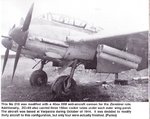The Me-410 was a light bomber. That's why it performed best at low altitude. If it had been designed to operate as a pathfinder @ 30,000 feet (i.e. like most Mosquitoes) it probably would have gotten different engines.
Hungarian built Me210s,with their lighter armament,armour and DB 605 A engines would be an exception.
GM-1 equipped versions flew with the Luftbeobachtungsstaffeln (don't you just love those compoumd nouns!). Fitted with a 300l drop tank under each wing they flew at high altitude above the US bomber formations reporting their numbers,position and course. They performed this role well into 1944. There is only one recorded loss,by Luftbeobachtungsstaffel 3 on 11 February 1944 which would certainly imply that they had adequate high altitude performance to evade the US escorts.
Cheers
Steve

